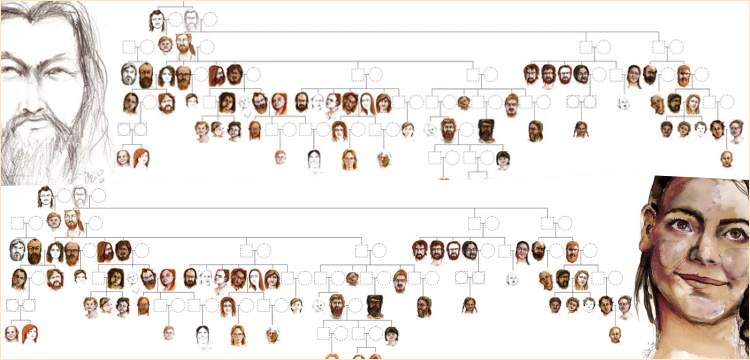Gurgy burials sheds light on the family relations of Neolithic societies

A new study that examined the remains of individuals in Gurgy burial ground in Paris sheds light on the family relations of Neolithic societies... Here are family trees from the European Neolithic period
C: Drawing by Elena Plain; reproduced with the permission of the University of Bordeaux / PACEA,
A new study published in Nature that examined the remains of 128 individuals provides insights into the family relations of Neolithic societies. According to the research, sons of Neolithic societies mostly stayed with their families and reproduced, while daughters left their families to join other agricultural societies as wives.

Distribution of the funerary site pits of Gurgy «les noisats» – (Illustration M. Le Roy).
Researchers led by the Max Planck Institute (MPI) for Evolutionary Anthropology in Leipzig and the University of Bordeaux had taken a closer look at human remains from the Gurgy «Les Noisats» cemetery in Paris.
Scientists used modern methods, including the analysis of the genetic material of 94 people, to examine the remains. They also used strontium isotope analysis to determine whether individuals grew up locally or elsewhere. They also determined the age, biological sex and location of the buried people.
Sons Stayed, Daughters Left
The ancestry data allowed scientists to create two independent family trees, a crowded one linking 64 people over seven generations and a smaller one showing the relationships of twelve individuals over five generations. These family trees showed the generations were linked almost exclusively through the fathers, indicating that the male descendants stayed within the community and had children with partners from outside the community.
Adult daughters, on the other hand, were not buried with the family, showing they left the community at a young age to join other communities as wives, possibly in mutual exchange. According to an MPI release, the fact that some women who married were distantly related indicates that such exchange alliances with a few neighbouring communities were common in Gurgy.
A Possibly Monogamous Society
"We see a large number of full siblings who had all reached reproductive age," says the lead author Maïté Rivollat. Therefore, the researchers assume "rather large families and a high reproductive capacity or fertility rate", as Rivollat emphasises. Researchers also point out that the family tree does not have any half-siblings, possibly indicating a monogamous way of life.
According to the research, the founding father of the community was originally buried elsewhere. Nevertheless, the community dug his remains from the burial ground in the community's previous settlement and reburied them in Gurgy. "So he must have been of great importance to the community as an ancestor [...]," explains co-author Marie-France Deguilloux.
The researchers say that the burial ground in Gurgy was used for more or less a century. The community had moved to Gurgy from a previous settlement, only to move again to another location. Considering the depletion of the local resources and the estimated duration of the era's dwellings, this constant resettlement seems fitting.
M. Enes Gençtürk- Arkeolojikhaber
Sourche: Max-Planck-Gesellschaft
